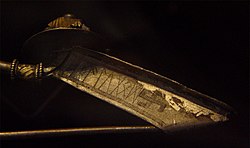Early-medieval : Brooch
The brooch has a backwards swastika design, achieved through the removal of four T-shaped sections, forming the openwork design. The front is decorated with five circular stamps, comprising of a dot within two concentric circles. One stamp is in the centre of the brooch, with the other four located at the end of each arm where it meets the brooch frame. The frame has a wide circular border, which is flat and albeit for the ring and dot motifs is undecorated.
The patina survives in a very good condition, it is a light greyish-green colour and slightly pitted. The brooch is in a good condition but is slightly bent towards the outer. The pin is missing, however the catchplate survives intact and a single lug survives, seemingly intact. It is pierced and contains corroded iron.
A parallel can be seen in LEIC-F79EA1 and dates to the Anglo Saxon period. This type of brooch is more akin to brooches from the South and East of England.
Relevante Bilder










































Relevante Artikel
SwastikaEine Swastika ist ein Kreuz mit vier etwa gleich langen, einheitlich abgewinkelten Armen. Sie können nach rechts oder links zeigen, recht-, spitz-, flachwinkelig oder rundgebogen und mit Kreisen, Linien, Spiralen, Punkten oder sonstigen Ornamenten verbunden sein. Solche Zeichen, das älteste von etwa 10.000 v. Chr., wurden in Asien und Europa, seltener auch in Afrika und Amerika gefunden. .. weiterlesen
